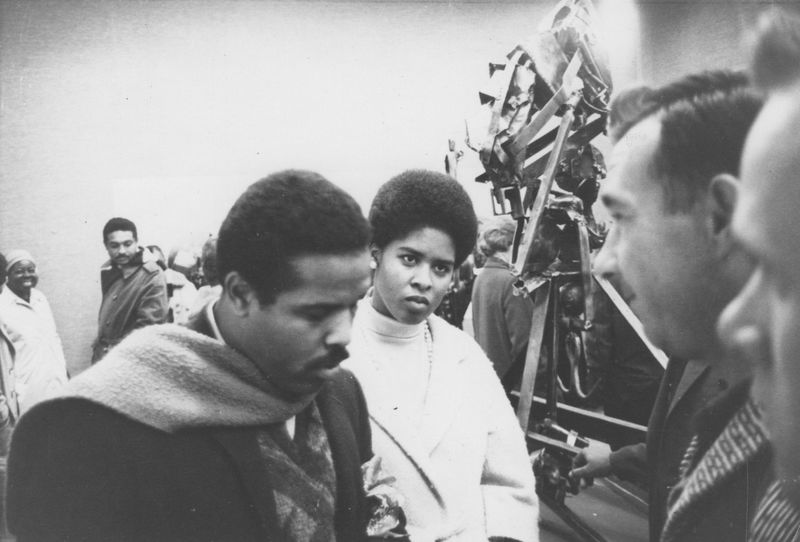
Melvin Edwards
Melvin Edwards left his hometown of Houston in 1955 to study at Los Angeles City College. Later he transferred to the University of Southern California (USC) to play football and study art. There he painted, took drawing courses, and learned to weld. Early in his career Edwards was recognized for his paintings, which were included in a citywide exhibition at Barnsdall Art Park in 1958.# It is with sculpture, however, that he made his mark. During breaks from USC, he studied sculpture at the Los Angeles County Art Institute (now Otis College of Art and Design) with Renzo Fenci, a sculptor known for his public commissions in Los Angeles. By 1963 Edwards had a studio on Van Ness Avenue, where he devoted his time almost exclusively to welding the sculptures that would make up the first phase of his important Lynch Fragment series.
Lasting from 1963 to 1967, the series consisted of primarily medium-scale abstract welded reliefs composed of chains, nails, spikes, bolts, and similar utilitarian tools and objects. Though nonfigurative, the works—as suggested by the series title and by the specific American history that connects objects such as chains to slavery—call forth an association of bondage with mechanization and the industrialized world. Initiated in California, the sculptures drew on Edwards's ideas about and personal relationship to the West, having lived in Texas and Ohio as a child, and his growing political awareness, shaped equally by the civil rights movement and by a fascination with Africa.# The hard geometric edges and frontality of sculptures such as Afro Phoenix #2 (1964) recall African masks, although Edwards explores a decidedly constructivist take on the form.
The years marking the beginning and the end of the series represent significant transitions for Edwards. In 1963 he made his first visit to New York, with fellow artist Daniel LaRue Johnson.# For a week they moved through the city, going to museums and meeting other artists, including William Majors. By 1967, when Edwards decided to move to New York permanently, he had graduated from USC (1965), joined the faculty at Chouinard Art Institute (1965–67), and had his first solo exhibition at the Santa Barbara Museum of Art (1965), in addition to being included in a number of group shows.

Once in New York, inspired perhaps by his relationships with public sculptors in Los Angeles, Edwards took on large public commissions in addition to his studio practice. His first was Homage to My Father and the Spirit (1969) at Cornell University in Ithaca. A painted steel disk bisected by a stepped wedge, the sculpture set the tone for the minimalist, geometric outdoor objects that followed, such as Harlem Double Circles (1970), a group of freestanding concentric circles that was installed in Harlem at the Bethune Towers housing complex. This sculpture reflected one of Edwards's other interests at the time: abstraction as an answer to social injustice. Edwards was invited by painter William T. Williams to join his mural-painting collective, the Smokehouse Painters, in 1968. Over the next two years the group painted hard-edge geometric murals on the walls of public spaces and residential buildings in upper Manhattan as a social experiment.#
The 1970s saw Edwards gaining national and international acclaim. In March of 1970 he had a solo sculpture show at the Whitney Museum of American Art, and later that summer he made his first trip to Africa, visiting Ghana, Nigeria, and Togo. He was awarded a National Endowment for the Visual Arts Fellowship in 1971 and a John Simon Guggenheim Memorial Foundation award in 1975. In 1977 he was invited to participate in the Second World Black and African Festival of Arts and Culture: FESTAC '77 in Nigeria. Over the following decades, Edwards resumed the Lynch Fragment series and expanded his sculptural practice. Much of this work was highlighted in his thirty-year retrospective at the Neuberger Museum of Art in Purchase, New York, in 1993.
In 2002 Edwards retired from teaching sculpture and drawing at Rutgers University, where he taught for thirty years.
—Courtney J. Martin
Selected Exhibitions
Melvin Edwards, Santa Barbara Museum of Art, California, 1965.
Five Younger Los Angeles Artists: Tony Belant, Melvin Edwards, Llyn Foulkes, Lloyd Hamrol, Philip Rich, Los Angeles County Museum of Art, 1965.
Melvin Edwards: Works, Whitney Museum of American Art, New York, 1970.
Melvin Edwards, Sculptor, Studio Museum in Harlem, New York, 1978.
Melvin Edwards Sculpture: A Thirty-Year Retrospective, 1963–1993, Neuberger Museum of Art, State University of New York at Purchase, 1993.
Selected Bibliography
Lynch Fragments: Selected Small Sculpture by Mel Edwards. Exh. cat. Introduction by Edward S. Spriggs. Atlanta: Hammonds House Galleries and Resource Center of African-American Art, 1991.
Mel Edwards. Exh. brochure. Cedar Rapids, Iowa: Cedar Rapids Museum of Art, 1992.
"Mel Edwards." Interview by Watson Hines. International Review of African American Art 7 (1987): 34–51.
Mercer, Valerie. "Sculptor's Horizons Have No Limits." New York Times, June 3, 1990.
Sculpture by Mel Edwards. Exh. cat. Trenton: New Jersey State Museum, 1981.
Selected Links
Melvin Edwards personal website.
Melvin Edwards biography page at the Alexander Gray Associates website.
Melvin Edwards Wikipedia page.
Michael Brenson, "Melvin Edwards," BOMB, November 24, 2014.


